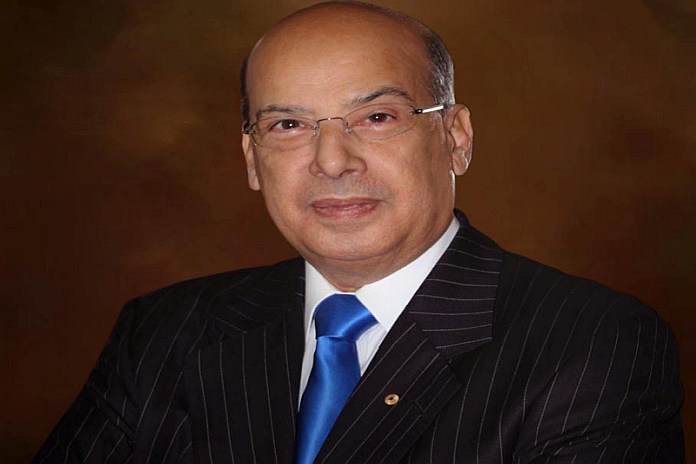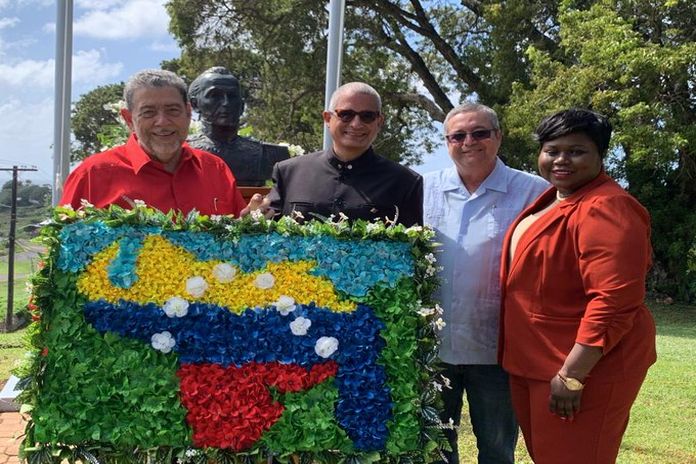By Sir Ronald Sanders
The New Year broke over Guyana with Guyanese everywhere deeply worried about the intentions of the Nicolas Maduro government in Venezuela which, through various communiques and public statements and action, appeared to be gearing up to seize the Essequibo region of Guyana.
A meeting, on December 14, 2023, in which Maduro and Guyana’s president, Irfaan Ali, participated in St Vincent, under the auspices of the prime minister of that country, Dr Ralph Gonsalves, eased fears of an imminent Venezuelan invasion, but it did not quell the sense of deep disquiet among the Guyanese people.
Into this scenario of anxiety and uncertainty, on Wednesday, January 3, 2024, a Venezuelan group posted a photograph on Facebook which was rapidly shared on social media networks. The photograph prompted swift condemnation of prime minister Gonsalves from many Guyanese. The picture showed the prime minister and his foreign minister, Keisal Peters, standing at the two ends of a line with two Venezuelans, who were holding, for the camera in front of them, a papier-mâché map of Venezuela which depicted Essequibo as Venezuelan territory. Behind Gonsalves was a statue of Simon Bolivar.
The photograph was described by the Venezuelans, who posted it, as “Very emblematic image of the PM of Saint Vincent and the Grenadines, paying homage to the liberator Simon Bolivar with a map of Venezuela that includes our Essequibo”. As happens when emotions are high and anxiety pervasive, none of those who commented on the Facebook post, checked either the age of the photograph or the circumstances in which it was taken.
There appeared to be a general assumption that the photograph was taken after the St Vincent meeting of December 14, which issued “The Joint Declaration of Argyle for Dialogue and Peace between Guyana and Venezuela.” In this connection, the comments on Facebook and on social media accused Gonsalves of acting in support of the Venezuelans by appearing in the company of Venezuelans with a map, showing Essequibo as part of Venezuela.
I was never persuaded that the Facebook post and the image it offered of Gonsalves, seeming to endorse Essequibo as a part of Venezuela, represented the truth of the situation. I immediately posted on the Facebook page, the following observation:
“I have known and highly regarded Dr Ralph Gonsalves for over 40 years. I cannot be convinced that, when he stood behind the artwork map, showing the Essequibo incorporated into Venezuela, he was made aware of the image being displayed. The Ralph Gonsalves, I know and respect, would not consciously do such a one-sided thing while the world awaits a decision on the Guyana-Venezuela controversy from the International Court of Justice, and while he, himself, is playing the role of CELAC’s honest broker.”
In order to write this commentary, I called Dr Gonsalves to learn his side of this story. He told me what he subsequently included in a letter to presidents Ali and Maduro, concerning this incident. He explained that he was not aware of the photograph but confirmed that it was taken at a ceremony commemorating Bolivar in St Vincent on the grounds of the Venezuelan Embassy in December 2022.
He went on to say in his letter, as he had told me: “While the photographs were being taken, I am advised that someone attached to the Venezuelan Embassy placed the “papier-mâché” depiction of the said map in front of us. I did not look at what the depiction was. I assumed that it was about Simon Bolivar.”
As all leaders know – politicians and otherwise – persons take photographs in which they appear but have little knowledge of anything or anyone that is not within their vision. Gonsalves was behind the map, and photographs are taken within seconds. That situation could have happened to anyone, and indeed, they frequently do.
He described the incident as “an innocent inadvertence on his part” and he regarded it as “unfortunate” that it “has been used by some to drum up, unnecessarily, antipathy of one kind or another.” He also understood “all the emotions attendant on this controversial issue”; and recognized that, as happened on this occasion, “from time to time there will be flare-ups.”
Gonsalves then said to both Ali and Maduro, “we as leaders must maintain a patience and a calm knowing that sun brightens stone, even as the river burns.” For those who do not recognize those words, they are taken from one of the iconic poems of Guyana’s Poet Laureate, the late Martin Carter, “Death of a Slave.” Dr Gonsalves went on to urge that “about this matter of the papier-mâché depiction, hopefully, it has been laid to rest, where it ought properly to reside among the assorted ghosts from the past, which ought never to rule us from the grave.”
None should forget that in the long months of 2020 as Guyana’s democracy was being sorely tested and the free will of the people, as expressed at the ballot box, was being jeopardised, Ralph Gonsalves stood in solidarity with all the people of Guyana, seeking peace, stability and democratic rights.
Like every man, Ralph Gonsalves, is not infallible but one thing is for certain, he is a Caribbean man and, he cares deeply about our one Caribbean region. Undoubtedly, he has a friendship with Maduro, and he is seeking, as best he can, to promote acceptance of a lasting solution to the Guyana-Venezuela controversy. That is Ralph Gonsalves’ nature. But he is no enemy of Guyana’s, and none should wrongly try to make him so.
He has explained himself fully and satisfactorily. As he has asked, the matter should be laid to rest.
Of the greatest importance now is that Guyana and its CARICOM partners must move forward, focusing on the legal and diplomatic efforts necessary to end the Venezuela controversy.






